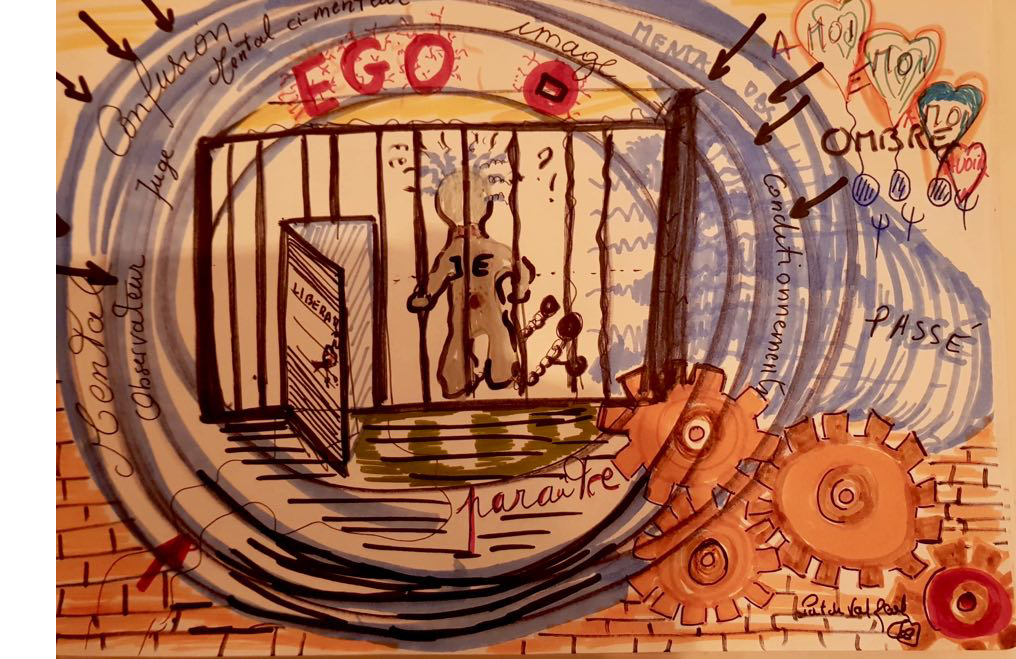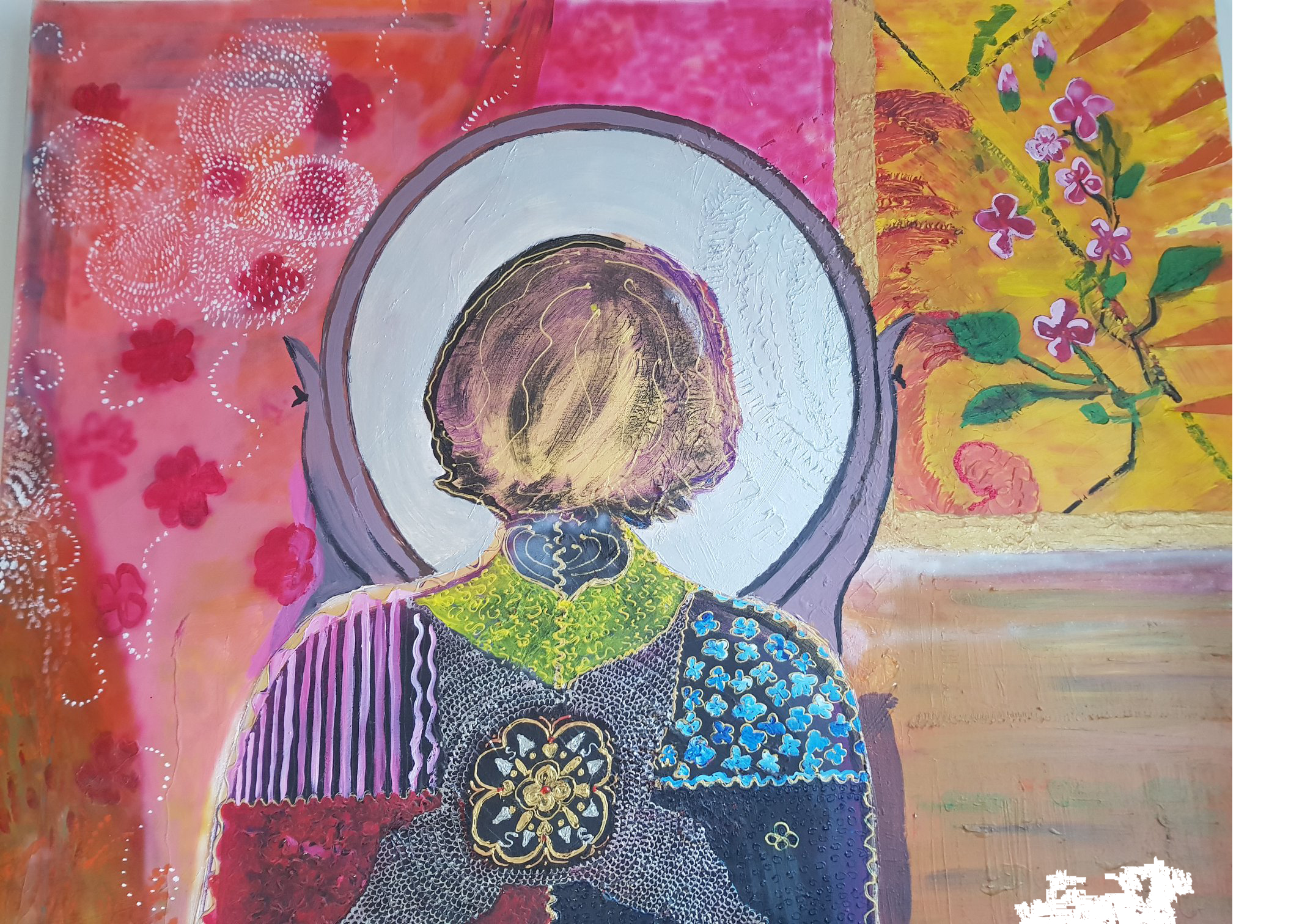WHAT IS « THE ILLUSION OR SENSE OF THE EGO » ?
We have to ask ourselves questions that are primordial. At the beginning, we come to consume knowledge, often after crises or changes in life or to resolve a substantive malaise. Our discomfort is then the lever to self-reflection. This malaise comes from our need for transcendence.
The ego is a knot to untie little by little with patience and perseverance, with all the sweetness that one would give to the education of a child. A notion of sustained effort must be observed so that this effort becomes a facility. Because sustained efforts lead to being effortless so that what has been achieved by constant effort is ultimately transcended. Then come spontaneity and pleasure. A directional force in the search for essentials will help to overcome obstacles. The ego always seeks security. Undoubtedly, risk taking is life.
The sense of ego is our usual functioning; it is the “I”, the “me” in which we build our knots. There is no question of destroying the ego because it only exists if we believe in it. We identify with it although it does not exist. The lure works well. This perception is experienced in rejection or possession, attraction or repulsion, “I like” or “I don’t like”. It only wants what is pleasant and avoids efforts. It is in constant struggle although it does not have an independent existence. It is a hold process of individualism. It’s duality. Out of ignorance of its nature, we make it an enemy. This attitude strengthens him and gives it veracity. We have to make it a friend. Can we Strike down our shadow?
The ego does not improve and does not change. Our obsessive mind gives us the illusion of continuity where it is easy to get caught up in turmoil and confusion. Illusion is the trength of the ego because, although it has no clear structure, it deludes us into believing in its own justifications and claims that affect us. It uses force and / or willpower to achieve its ends. It is it who disturbs the path and the vision, because it wants to be absolute and perfect. It is an intruder, a judge, a preserver and an observer. It takes root in our animal’s esires and fears. It maintains the ghosts of the past, in our fears and in our compensatory fantasies. Prison well-guarded by the belief in freedom and this usurper easily deludes us because the “gadget” society supports it.
The question of the ego’s illusion is paramount because it obstructs openness to higher levels of consciousness. The moods are like clouds in the sky. They form, grow, swell, thicken, pierce and disappear. What is their reality? The sky is still blue above and the sun continues to shine despite the clouds … But who are we? Do we really know ourselves?
The ego has no real consistency, we only observe manifestations. We could let go of the idea of conserving the past and any notion of ego would disappear. Because in the present, the past is dead. Duality torns us between a hidden inner image and an outer image of representation-appearance. We are in duality, not knowing how to solve this problem. We do not accept being torn, and that is normal! This existence is dual. It is important to learn to cut from the past, source of suffering, withdrawal, closure, and protection. Being in Presence changes our relationship to time and therefore to the notion of ego. We have at our disposal a new software, a knowledge space. Consuming information fills the heads with subjects that we don’t care about. The main thing is to sort the useful information.
WHAT IS « THE ILLUSION OR SENSE OF THE EGO » ?
By the following analogy we will see the development of the sense of the ego. The only way to see oneself is, in front of a mirror which sends us an image, a reflection. He reproduces, imitates, focusing on the details. The ego does not exist but identified…
Now imagine it in a face-to-face scene with a psyche, this large and magnificent wooden mirror, present in the family for several generations. It looks at itself, always with the same look and the same desire to ensure that its image is sufficiently correct or even perfect. In this calculation, it hopes to manage and control all the details in the best possible way, using artifice of its image, its body, its emotions, the unspoken, anything it does not want to show. It has an intimate relationship with itself. It sends back to it the various facets of its face and its personality.
It hides in the dark so in this game of darkness or light, this psyche will send it a reflected image. It sneaks a glance; It is amazed not to recognize itself immediately. It’s surprising: “Ah yes, it’s me I see in the mirror”. It accounts its possessions by pointing to its navel, the center of the world; its egocentrism does not scare it.
It’s me, it’s my shape, it’s my body, it’s my look, basically, it’s my home, it’s all mine, it’s my territory. ” It has a name, an identity, with which it identifies. It claims who / what it looks like or who / what it doesn’t want to look like. It is attached to this image although it is only a reflection in a mirror. The illusion fascinates it.
All its past brings up fears and desires. The desire to conquer and the fear of losing, a confrontation in duality is raging. This amalgam is so well put together, neatly stored in drawers (with a scent of lavender, chocolate or oriental spices) that it believes in it, and keeps it in the same operating environment with the same references. And there, in this instant, facing the mirror, it asks itself the question “but who am I, static in this frame?” By observing itself, it notes bitterly that it does not know itself, at the least it does not recognize himself.
Does it like this person it sees?
At that moment it realizes that the image in the mirror is independent of the one who says “do I like this image?” This image fascinates it, for good or for bad. It represents it. As soon as it is confronted with the limits of the frame of the mirror, it panics, it becomes aware of the frame and says to itself: “it is my frame my landmark, my reference, what is inside and outside the frame, is my possession”, especially if the frame is golden. It will take care of beautifying its environment and will never let go of anything, it will accumulate dusty objects, outdated books but will not let go; it will then want to go further than the mirror and enlarge this space, but as soon as it escapes from in front of the mirror, it disappears, it generates a stress it must not move so it freezes, it freezes all the environment that surrounds it, it is like death to it; although it is only a reflection of itself (an illusion) it believes in it, and identifies with this image there; As soon as it begins to notice that it is in an enclosed frame (the frame of the mirror), it will try to fill the entire mirror, it will confront this reflection by saying to itself “but how do I get out of this box “and at the same time it does not want to leave it otherwise it loses its image and its security with it, that does not suit it, it cannot let go of this vision of itself otherwise it will let go of its frame and its way of looking at itself. If it leaves the frame to see itself, there is no one left, then it is frightened because its image is no longer reflected, it loses its footing, it loses its bearings; so it will maintain and want to keep this image which seems reassuring to it (it does not know any other image) and the operating fold is this way of continuously observing itself in the same way in a precise and enclosing framework.
If it dares to move and leave the frame empty, letting go occurs, it agrees to be divested; So it can ask itself “but who was this reflection in the mirror?” What is the reality of this reflection, and who is asking the question, and who is attached to this image, and who lives behind these eyes?
There settles an enlightening vision.
We can at least examine the fact that often we are more interested in the image that there is in the mirror, which obsesses us, which fascinates us, than in the manner of observing ourselves. To stop observing oneself would mean losing this image, and then arises the fear of losing it, it absolutely does not want to lose the identification with its image. Identification is psychic and often irrational. The observation criteria are conditioned by our experience and our culture. We do not look in a detached way, there is no detachment there. By observing the operating fold, we can thus see what we are locked into.
| One cannot regulate a mental process by the mental itself. |
IT IS THE DEVELOPMENT OF THE SENSE OF THE EGO
This hellish process uses a mental gear system to collect everything and above all justify its collection to ultimately have the final word. It is a trend of exponential development of an oversized egocentricity. A form of reality that is just a reflection, but with which I identify. The more the mechanisms are refined and chiseled, the smarter we get. We start to learn things about ourselves, and we use them thinking we can improve. We do not realize that we are strengthening the ego, we lack vigilance. It’s a game where the dice are loaded, and where we play seriously. Arrangement is a way of substituting the effort of this vigilance.
We complexify, we see constraints everywhere, and that suits us because in this way we justify disdainfully or casually, and we dismiss effort, perseverance and vigilance. We use knowledge to avoid facing the difficulty. We are developing a form of flight and maintenance in that state. We can do the same by an exaggeration, excessiveness in a search for perfection, with a constant dissatisfaction. Everything must be smooth, impeccable. All we are doing is searching, we put ourselves in overabundance. It also keeps us in there as we are still observing the details. We use knowledge to be self-sufficient and never let go, we are in an accumulation of knowledge with an amplification of the discursive mind and its resistances. It’s hard.
These are pitfalls encountered on a path in a spiritual way. Inevitably.
In these cases, these wheels spin in emptiness and we do not leave the frame in which we have locked ourselves. As we do not know how to get out, in a new attempt, we sublimate the brown frame by a decoration, a painting; by a flicker… we gild the brown frame with golden paint and have created a light frame by thinking that we see the light by affirming “I see the light”.
IT’S FALSE LIGHT
Arrogance, pretension, sufficiency, pride in believing that one sees the light because if I see the light I am not the light. I can’t get out of this picture, it fascinates me. There it is useful to realize that one’s construction is dependent on one’s affectivity. The comparison is always made from the known.
But finally, I appreciate being frozen in this mirror where nothing moves, safely, like a painting hanging in a museum. Protected by the guardian who is I and who observes me. Frozen, in this operating framework that I validate. It is the observer who observes himself. All in all, I don’t want anyone to come and take down this framework in which I justify my existence.
A little humor, it is the only way out:
The utmost is that the museum visitor does not look at the painting, everyone ignores us, they look at the other passers-by, they look at themselves while describing the painting.
Usually we observe ourselves and judge our way of doing things or our way of being. There, it is a question of being a spectator, and therefore of seeing with detachment (without identification with our egotic knots). Seeing our identifications shows us that what sees in us is not the ego, it is the Being, our luminous part.
Taking a step back as a spectator gives a vertical vision of the situation and always in a bright direction. The way out is not to delve into the depths of the abyss of the unconscious, but to pose a spectator‘s vision. Anyone who is a spectator of this scene can only be the Being because he is himself detached from the body that he sees and from the game that tells him that this body belongs to him.
We do not change either the mirror or the body, but just our vision. The Arcana there become very interesting to study, because they are the multiple facets of these reflections. They are like the shield of Perseus: it is through the shield that one can examine the gorgon or the dragon with several heads.


